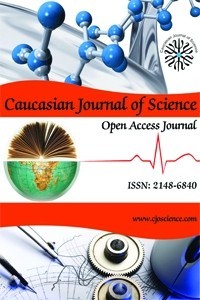Abstract
Trigonella
foenum-graecum seed was extracted with water-alcohol by maceration
method. Its antimicrobial activity was tested by well diffusion technique
againist Bacillus subtilis, Bacillus cereus, Escherichia coli,
Pseudomonas aeroginosa, Pasteurella multocida, Yersinia enterocolitica, Klebsiella pneumoniae,
Staphylococcus aureus bacteria and Candida albicans, Rhodotorula glutinis yeast and standard
antibiotics.
Extract of Trigonella
foenum-graecum seed was detected to be effective against
Gram (+) and Gram (-) bacteria and yeasts. Best
antibacterial activity has been found against P. multicoda (22 mm) and best
activity for yeasts has been found against R. glutinis (20 mm)
In general,
the antimicrobial activity of Trigonella
foenum-graecum seed extract is lower than penicillin and erythromycin
antibiotics.
References
- Dülger, B.. Ceylan M., Alıtsaous, M. (1999). Artemisia absinthium L. (Pelin)’un Antimikrobiyal Aktivitesi, Tr. J. of Biology 23, 377–384.
- Fazli, F. R. Y., & Hardman, R. (1968). The Spice, Fenugreek (Trigonella foenum-graecum L.): Its Conmmercial Varieties of Seed as a Source Mehrafarin & Authors of Diosgenin. Tropical Science, Vol.10, p. 66-78.
- Furigaa, A., Lonvaud-Funelb, A., Badeta, C. (2009). In vitro study of antioxidant capacity and antibacterial activity on oral anaerobes of a grape seed extract, Food Chemistry 113(4), 1037–1040.
- Goncagül, G., Ayaz, E. (2010). Antimicrobial Effect of Garlic (Allium sativum) and Traditional Medicine; Journal of Animal And Veterinary Advances 9 / 1 Pages: 1-4.
- Hamza, N., Berke, B., Cheze, C., Le Garrec, R., Umar, A., Agli, A. N., ... & Moore, N. (2012). Preventive and curative effect of Trigonella foenum-graecum L. seeds in C57BL/6J models of type 2 diabetes induced by high-fat diet. Journal of ethnopharmacology, 142(2), 516-522.
- Kchaou, W., Abbès, F., Mansour, R. B., Blecker, C., Attia, H., & Besbes, S. (2016). Phenolic profile, antibacterial and cytotoxic properties of second grade date extract from Tunisian cultivars (Phoenix dactylifera L.). Food chemistry,194, 1048-1055.
- Levy SB., (1982). Microbial resistance to antibiotics. An evolving and persistent problem. Lancet, 10:83-88.
- Mohamad, S., Taha, A., Bamezai, R. N. K., Basir, S. F., & Baquer, N. Z. (2004). Lower doses of vanadate in combination with trigonella restore altered carbohydrate metabolism and antioxidant status in alloxan-diabetic rats. Clinica chimica acta, 342(1), 105-114.
- Pandian, R. S., Anuradha, C. V., & Viswanathan, P. (2002). Gastroprotective effect of fenugreek seeds (Trigonella foenum graecum) on experimental gastric ulcer in rats. Journal of ethnopharmacology, 81(3), 393-397.
- Petit, P., Sauvaire, Y., Ponsin, G., Manteghetti, M., Fave, A., & Ribes, G. (1993). Effects of a fenugreek seed extract on feeding behaviour in the rat: metabolic-endocrine correlates. Pharmacology Biochemistry and Behavior, 45(2), 369-374.
- Piao, C. H., Bui, T. T., Song, C. H., Shin, H. S., Shon, D. H., & Chai, O. H. (2016). Trigonella foenum-graecum alleviates airway inflammation of allergic asthma in ovalbumin-induced mouse model. Biochemical and Biophysical Research Communications.
- Shankaracharya, N. B., Anandaraman, S., & Natarajan, C. P. (1973). Chemical composition of raw and roasted fenugreek seeds. Journal of food science and technology.
- Smid, E. J., & Gorris, L. G. M. (1999). Natural antimicrobials for food preservation. In M. Shafiurr Rahman (Ed.), Handbook of food preservation (pp. 285–308). New York: Marcel Dekker.
- Submuth, R.; Eberspaecher , J.; Haag,R.; and Sprınger, W. (1987). Biochemisch Mikrobioogisches Prakticum.Thieme Verlag-Stuttgart, 409s.
- Xanthopoulou, MN., Nomikos, T., Fragopoulou, E., Antonopoulou, S.( 2009) Antioxidant and lipoxygenase inhibitory activities of pumpkin seed extracts, Food Research International 42 / 5-6, Pages: 641-646.
- Yılmaz, Y. (2006) Novel uses of catechins in foods, Trends in Food Science and Technology, 17, 64-71.
Abstract
References
- Dülger, B.. Ceylan M., Alıtsaous, M. (1999). Artemisia absinthium L. (Pelin)’un Antimikrobiyal Aktivitesi, Tr. J. of Biology 23, 377–384.
- Fazli, F. R. Y., & Hardman, R. (1968). The Spice, Fenugreek (Trigonella foenum-graecum L.): Its Conmmercial Varieties of Seed as a Source Mehrafarin & Authors of Diosgenin. Tropical Science, Vol.10, p. 66-78.
- Furigaa, A., Lonvaud-Funelb, A., Badeta, C. (2009). In vitro study of antioxidant capacity and antibacterial activity on oral anaerobes of a grape seed extract, Food Chemistry 113(4), 1037–1040.
- Goncagül, G., Ayaz, E. (2010). Antimicrobial Effect of Garlic (Allium sativum) and Traditional Medicine; Journal of Animal And Veterinary Advances 9 / 1 Pages: 1-4.
- Hamza, N., Berke, B., Cheze, C., Le Garrec, R., Umar, A., Agli, A. N., ... & Moore, N. (2012). Preventive and curative effect of Trigonella foenum-graecum L. seeds in C57BL/6J models of type 2 diabetes induced by high-fat diet. Journal of ethnopharmacology, 142(2), 516-522.
- Kchaou, W., Abbès, F., Mansour, R. B., Blecker, C., Attia, H., & Besbes, S. (2016). Phenolic profile, antibacterial and cytotoxic properties of second grade date extract from Tunisian cultivars (Phoenix dactylifera L.). Food chemistry,194, 1048-1055.
- Levy SB., (1982). Microbial resistance to antibiotics. An evolving and persistent problem. Lancet, 10:83-88.
- Mohamad, S., Taha, A., Bamezai, R. N. K., Basir, S. F., & Baquer, N. Z. (2004). Lower doses of vanadate in combination with trigonella restore altered carbohydrate metabolism and antioxidant status in alloxan-diabetic rats. Clinica chimica acta, 342(1), 105-114.
- Pandian, R. S., Anuradha, C. V., & Viswanathan, P. (2002). Gastroprotective effect of fenugreek seeds (Trigonella foenum graecum) on experimental gastric ulcer in rats. Journal of ethnopharmacology, 81(3), 393-397.
- Petit, P., Sauvaire, Y., Ponsin, G., Manteghetti, M., Fave, A., & Ribes, G. (1993). Effects of a fenugreek seed extract on feeding behaviour in the rat: metabolic-endocrine correlates. Pharmacology Biochemistry and Behavior, 45(2), 369-374.
- Piao, C. H., Bui, T. T., Song, C. H., Shin, H. S., Shon, D. H., & Chai, O. H. (2016). Trigonella foenum-graecum alleviates airway inflammation of allergic asthma in ovalbumin-induced mouse model. Biochemical and Biophysical Research Communications.
- Shankaracharya, N. B., Anandaraman, S., & Natarajan, C. P. (1973). Chemical composition of raw and roasted fenugreek seeds. Journal of food science and technology.
- Smid, E. J., & Gorris, L. G. M. (1999). Natural antimicrobials for food preservation. In M. Shafiurr Rahman (Ed.), Handbook of food preservation (pp. 285–308). New York: Marcel Dekker.
- Submuth, R.; Eberspaecher , J.; Haag,R.; and Sprınger, W. (1987). Biochemisch Mikrobioogisches Prakticum.Thieme Verlag-Stuttgart, 409s.
- Xanthopoulou, MN., Nomikos, T., Fragopoulou, E., Antonopoulou, S.( 2009) Antioxidant and lipoxygenase inhibitory activities of pumpkin seed extracts, Food Research International 42 / 5-6, Pages: 641-646.
- Yılmaz, Y. (2006) Novel uses of catechins in foods, Trends in Food Science and Technology, 17, 64-71.
Details
| Journal Section | Research Article |
|---|---|
| Authors | |
| Publication Date | December 29, 2017 |
| Submission Date | March 16, 2017 |
| Acceptance Date | December 4, 2017 |
| Published in Issue | Year 2017 Volume: 4 Issue: 1 |







